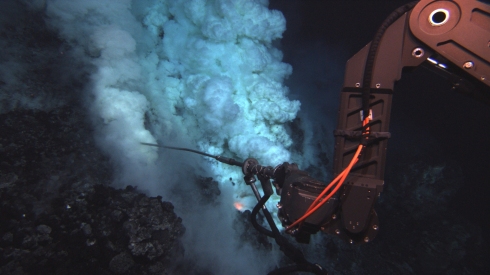
The Jason remotely-operated vehicle (ROV) samples fluid at an eruptive area near the summit of the West Mata Volcano. The fluid sampling “wand” is approximately three feet long. (Photo/Courtesy of NSF and NOAA)
With bulbous burps of molten lava, roiling submarine steam and a thunderous roar, an ocean floor is born. In a scene straight from the origins of our planet, scientists have for the first time captured high definition video of the deepest recorded underwater volcanic eruptions. Researchers from NOAA and the National Science Foundation unveiled two short video clips, (one posted below), during a press conference today at the fall meeting of the American Geophysical Union.
The ocean floor is almost entirely formed by lava oozing from beneath, yet this process is poorly understood and never before observed in this way. “On our very own planet we haven’t seen lava flowing on the sea floor. We haven’t seen ocean crust being made,” said Joe Resing with the University of Washington and NOAA’s Pacific Marine Environmental Laboratory.
“It’s a spectacular process to watch,” said microbiologist Julie Huber with the Marine Biological Laboratory.
Vodpod videos no longer available.The cacophonous bubbling mass of note is the West Mata submarine volcano in the Northeast Lau Basin, about a half a day’s ship ride from western Samoa. Almost two miles beneath the surface of the ocean lies a volcano about six miles long, four miles wide and one mile high that to best knowledge may have been erupting continuously for the past five months, according to the scientists at a press conference during the American Geophysical Union fall meeting.
Shrimpy smorgasbord – The environment is so new and acidic, hovering somewhere between battery acid and stomach acid, that not much has colonized the volcano yet, but hydrothermal vent shrimp are on the scene, along with fields of microbes for the shrimp to munch on. Not only do the tiny crustaceans appear to be early colonizers, but they come from far away. The species observed are the same ones found in Hawaii and Guam so may be dispersing from as far as 4,000 miles away, said Woods Hole Oceanographic Institute’s Tim Shank.
How underwater rock formations are created – Geology is often about looking at rocks frozen in time, now scientists can stop using their imaginations and see the process in action. One type of formation captured on video, known as Bonanite lavas, are thought to be among the hottest eruptions on Earth, and have previously only been seen long after they’ve cooled.
What they sound like – Scientists dangled a hydrophone from the remote-controlled submersible to record the roar of the volcano. If you know the basics of physics, water is an excellent conveyer of sound. The deep ocean might require earplugs.
Closing in on the action – Being underwater actually affords scientists a more intimate view of an active volcano. On land being so close to the source of an eruption would mean bye-bye for the curious cat or their equipment, but the oceanic environment provides enough buffer to see these eruptions from meters away as opposed to miles.


December 18th, 2009 at 1:02 am
WOW! Kewl.
February 7th, 2010 at 4:54 pm
Good post. Interesting read. I read something similar yesterday but for the life of me I can’t remember what the site was though. It’ll come to me – it must be old age 🙂
February 21st, 2010 at 5:45 pm
‘Spectacular’ is exactly right. Your descriptions of it are spot-on. There is something about marine biology and geology that is so (much more?) fascinating than that on the surface – perhaps the mystery. Will we lose that as we discover more about it? Great post.